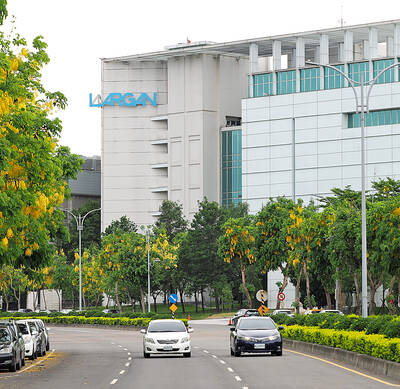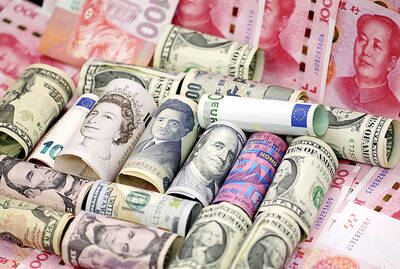Handset chip designer MediaTek Inc (聯發科) yesterday expressed confidence that it would be able to recover some lost turf next year as its recovery plan begins to bear fruit earlier than expected, as evidenced by a rebounding gross margin.
MediaTek attributed the improvement primarily to a repositioning of its mobile processor strategy to focus on the mid and high-performance Helio P series, which target smartphones with a price tag of 1,500 yuan to 3,000 yuan (US$230 to US$460), while halting marketing for the Helio X series, which is used in premium phones.
The strategic shift was made about seven months ago, when semiconductor veteran Rick Tsai (蔡力行) was appointed co-CEO to help steer the company through a rough time.
The company had seen its gross margin and market share slide due to intensifying competition, mainly from Qualcomm Inc.
The change has borne fruit, with the Helio P series processors being adopted by some of the world’s top five mobile phone brands, including China’s tier-one mobile brands Huawei Technologies Inc (華為), Oppo Mobile Telecommunications Corp (歐珀移動) and Vivo Electronics Corp (維沃移動通信).
“We have seen our gross margin stabilize and gradually recover, indicating that our mobile business is stabilizing,” Tsai told a media briefing.
MediaTek saw its gross margin pick up to 36.4 percent in the third quarter, from 35 percent in the second quarter, stemming 13 quarters of declines.
“Our next step is to take back some of the market share we lost. We are confident that we can do it and that our gross margin will continue to grow mildly and stably,” Tsai said.
To reclaim lost turf, MediaTek plans to roll out more new processors from its Helio P family, including the Helio P40, in the first half of next year, after its new Helio 23 and Helio 30 processors gained traction this quarter.
“We are cautiously optimistic about the company’s outlook next year,” Tsai said. “Although mobile phone growth in China is slowing, we still expect replacement demand in emerging markets to drive growth.”
MediaTek also attributed the business recovery to its enhanced technological capabilities.
The company’s new processors will incorporate artificial intelligence (AI) technology, allowing users to take better-quality pictures, the company said.
“AI technology will be extended to be used at the edge, or on end products. This will be a very important trend in the next two to three years. MediaTek will apply AI technology to both our mobile and home platforms,” company president Joe Chen (陳冠州) said.
The chipmaker also plans to apply AI technology to its chips for autonomous vehicles.
The company plans to roll out three 7-nanometer processors next year made by Taiwan Semiconductor Manufacturing Co (台積電), Tsai said.
Most of MediaTek’s advanced processors currently deploy 12-nanometer technology, he said.

Handset camera lens maker Largan Precision Co (大立光) on Sunday reported a 6.71 percent year-on-year decline in revenue for the third quarter, despite revenue last month hitting the highest level in 11 months. Third-quarter revenue was NT$17.68 billion (US$581.2 million), compared with NT$18.95 billion a year earlier, the company said in a statement. The figure was in line with Yuanta Securities Investment Consulting Co’s (元大投顧) forecast of NT$17.9 billion, but missed the market consensus estimate of NT$18.97 billion. The third-quarter revenue was a 51.44 percent increase from NT$11.67 billion in the second quarter, as the quarter is usually the peak

Taiwan’s foreign exchange reserves hit a record high at the end of last month, surpassing the US$600 billion mark for the first time, the central bank said yesterday. Last month, the country’s foreign exchange reserves rose US$5.51 billion from a month earlier to reach US$602.94 billion due to an increase in returns from the central bank’s portfolio management, the movement of other foreign currencies in the portfolio against the US dollar and the bank’s efforts to smooth the volatility of the New Taiwan dollar. Department of Foreign Exchange Director-General Eugene Tsai (蔡炯民)said a rate cut cycle launched by the US Federal Reserve

The US government on Wednesday sanctioned more than two dozen companies in China, Turkey and the United Arab Emirates, including offshoots of a US chip firm, accusing the businesses of providing illicit support to Iran’s military or proxies. The US Department of Commerce included two subsidiaries of US-based chip distributor Arrow Electronics Inc (艾睿電子) on its so-called entity list published on the federal register for facilitating purchases by Iran’s proxies of US tech. Arrow spokesman John Hourigan said that the subsidiaries have been operating in full compliance with US export control regulations and his company is discussing with the US Bureau of

Pegatron Corp (和碩), a key assembler of Apple Inc’s iPhones, on Thursday reported a 12.3 percent year-on-year decline in revenue for last quarter to NT$257.86 billion (US$8.44 billion), but it expects revenue to improve in the second half on traditional holiday demand. The fourth quarter is usually the peak season for its communications products, a company official said on condition of anonymity. As Apple released its new iPhone 17 series early last month, sales in the communications segment rose sequentially last month, the official said. Shipments to Apple have been stable and in line with earlier expectations, they said. Pegatron shipped 2.4 million notebook